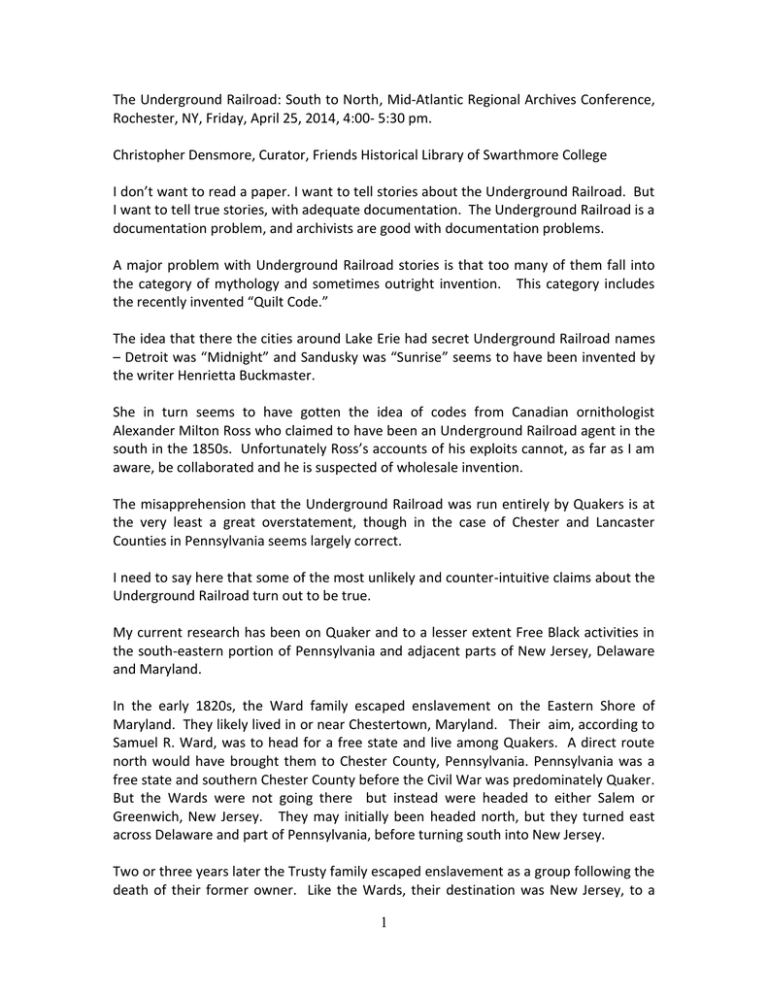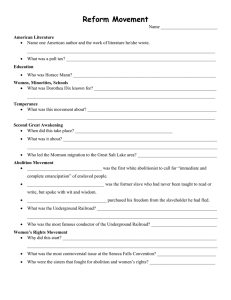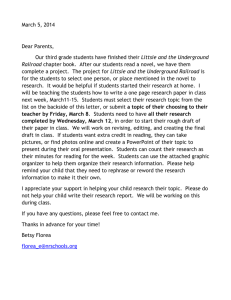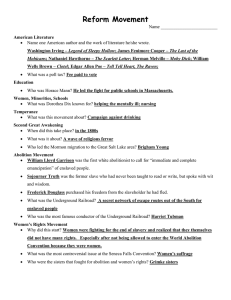S13 Densmore.doc (36Kb)
advertisement

The Underground Railroad: South to North, Mid-Atlantic Regional Archives Conference, Rochester, NY, Friday, April 25, 2014, 4:00- 5:30 pm. Christopher Densmore, Curator, Friends Historical Library of Swarthmore College I don’t want to read a paper. I want to tell stories about the Underground Railroad. But I want to tell true stories, with adequate documentation. The Underground Railroad is a documentation problem, and archivists are good with documentation problems. A major problem with Underground Railroad stories is that too many of them fall into the category of mythology and sometimes outright invention. This category includes the recently invented “Quilt Code.” The idea that there the cities around Lake Erie had secret Underground Railroad names – Detroit was “Midnight” and Sandusky was “Sunrise” seems to have been invented by the writer Henrietta Buckmaster. She in turn seems to have gotten the idea of codes from Canadian ornithologist Alexander Milton Ross who claimed to have been an Underground Railroad agent in the south in the 1850s. Unfortunately Ross’s accounts of his exploits cannot, as far as I am aware, be collaborated and he is suspected of wholesale invention. The misapprehension that the Underground Railroad was run entirely by Quakers is at the very least a great overstatement, though in the case of Chester and Lancaster Counties in Pennsylvania seems largely correct. I need to say here that some of the most unlikely and counter-intuitive claims about the Underground Railroad turn out to be true. My current research has been on Quaker and to a lesser extent Free Black activities in the south-eastern portion of Pennsylvania and adjacent parts of New Jersey, Delaware and Maryland. In the early 1820s, the Ward family escaped enslavement on the Eastern Shore of Maryland. They likely lived in or near Chestertown, Maryland. Their aim, according to Samuel R. Ward, was to head for a free state and live among Quakers. A direct route north would have brought them to Chester County, Pennsylvania. Pennsylvania was a free state and southern Chester County before the Civil War was predominately Quaker. But the Wards were not going there but instead were headed to either Salem or Greenwich, New Jersey. They may initially been headed north, but they turned east across Delaware and part of Pennsylvania, before turning south into New Jersey. Two or three years later the Trusty family escaped enslavement as a group following the death of their former owner. Like the Wards, their destination was New Jersey, to a 1 location near Greenwich, New Jersey. That small rural neighborhood is still home to a significant African-American population and a smaller Quaker population, not exactly living together but side by side. The Trusty family was part of the estate of their former owner, William Spencer. The settlement of the estate took a number of years and thereby left a lot of documentation. Among these records were the expenditures made over several years to recover their lost “property.” [See power point slide] It appears that both the freedom seekers and those who wished to re-enslave them had some knowledge of African-American and Quaker populations in New Jersey. Both the Wards and the Trusty families eventually moved to New York City. [Power Point Slide] CHARGES FOR PURSUING RUNAWAY NEGROES AND STOLEN HORSES 1822 May. Expenses to Smyrna, Appoquinimink, New Castle, Port Penn & Wilmington at $2.50 per day for each 4 days 20.00 1823 August. Expenses & costs to Philadelphia and Frankfort $50.00 1824 June. Expenses to Dover, Marsh Town, Leipsic, Appoquinimink Penn, New Castle, Christiana & Newark@ $2.00 per day for each 16.00 1826 June. Expenses to Jersey 4 days @ $2.50 pr. day for each 20.00 1827 June. Expenses and other Charges to Philadelphia, Salem & Bridge Town in Jersey 4 days @ $2.50 pr. day for each 20.00 1830 January. Expenses and other Charges to Salem 2 days. 12.00 A list compiled Underground Railroad agents in Chester County includes 138 names. Of these, 107 were identified by religion: 82 Quakers and 17 African-American Methodists. The number of African-Americans involved with the Underground Railroad is undoubtedly larger, but less easy to document. In 1860, Quakers made up about 5% of the church-going population of Chester County. In addition to mythologies, we also have models and models can sometimes help and sometimes obstruct. In the usual understanding, freedom seekers were headed north. Not so. I think it is better understood that they were seeking a place of safety with employment and educational opportunities. This usually meant finding an existing African-American population and a Euro-American population inclined to offer employment and disinclined to assist slave catchers. 2 In the 1860 Federal Census, African-Americans were overall 2% of the population of Pennsylvania, 4% of the population of Philadelphia, and 8% of the population of Chester County. The distribution of the African-American population in those areas is quite suggestive particularly when viewed at the township level. African American Population of Chester County Townships, 1860 1860 1860 1860 1860 1860 1860 1860 Chester Chester Chester Chester Chester Chester Chester Pocopsin 617 W. Goshen 1067 Westtown 659 Kennett 1905 London Grove 1642 E. Marlboro 1476 COUNTY 74578 181 287 128 310 249 221 5907 29.3 26.9 19.4 16.3 15.2 15 7.9 This was also the location of what might be thought of as a low level border was dating from at least forty years prior to the Civil War and sometimes breaking out into armed confrontations such as the Christiana Riot (or Resistance) in September 1851. The leaders of the Resistance escaped to Buxton, Ontario. But the Underground Railroad usually runs north to Canada? Right? In 1828 the man who later became James W.C. Pennington headed north from Maryland to Pennsylvania. He likely crossed into Pennsylvania into Adams County, in center of the southern tier. He had no Pennsylvania contacts and little idea of where to go until a kind soul pointed him towards the home of William and Phoebe Wright. He stayed there several months, working and learning how to read. He then went further east to the home of J.K. (probably Jesse Kersey) in Chester County, and finally to Long Island. Assuming his original intention was to head to Canada, or at least much further north, he could have traveled almost due north which would have brought him to Rochester. He could have followed the route of the Susquehanna River. Instead he, and as far as I can determine, most freedom seekers crossing into Pennsylvania, goes east. Of course we need to dispel the idea that the Underground Railroad involved actual trains. Or do we? William Whipper, and African-American lumber merchant in Columbia, Pennsylvania, on the Susquehanna River, shipped freight cars filled with lumber to Philadelphia, some of the cars also including freedom seekers. It is clear that some people in Chester County were aware of the work of former freedom seeker and then Underground Railroad agent in Elmira, New York, facilitated escapes via the railway lines from Phildelphia and Reading, to Elmira, and eventually to Niagara Falls (aka Suspension Bridge). 3 My mental map of south-eastern Pennsylvania is based on the location of Quaker meetings. For the Underground Railroad, I add the location of African Union Churches-often within a mile of the nearest Quaker meeting—and African-American populations. Some Quaker areas were more active than others, but when charting anti-slavery and Underground Railroad activity, the area of convergence involves Quakers, AfricanAmericans and known abolitionist activity. My mental map of Upstate New York adds Wesleyan Methodists and Free Will Baptists. Of course freedom seekers passing though south-eastern Pennsylvania did often go to Canada, just not as often or assuredly as we might think. My final story is about Niagara Falls (whose role as a station on the Underground Railroad is not yet fully appreciated. Dillwyn Parrish, a Quaker from Philadelphia with decidedly anti-slavery leanings is approached by an African-American man who asks him if by any chance is he related to Samuel M. Janney of Virginia. Dillwyn is not, but certainly knows Samuel Janney as a fellow abolitionists and one with decidedly antislavery sentiments. I will leave it to you whether the two men look alike. [power point slide]. I suspect Dillwyn might have been marked for his Quaker dress and therefore someone relatively safe to approach. The man was from Virginia, and wished to get a letter to his wife in Virginia, and was hoping that Samuel Janney would assist. Presumably he would. The Underground Railroad worked on trust. In “my” area at least there a network of trusts. Quaker networks are often bound together not only by shared religious commitment, but also common anti-slavery views and not infrequently by family ties. In closing, it is important to understand that people are often vary invested in the Underground Railroad stories because the story is about race and race continues to be important. I used to worry that my lectures on the Underground Railroad would quickly become in the question and answer period discussions of modern race relations and racial identity. 4


